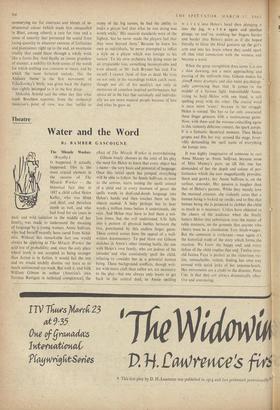Theatre
Water and the Word
GASCOIGNE
By BAMBER
The Miracle Worker. (Royalty.) I r happened. It actually happened. This is the most crucial element in the success of The Miracle Worker — the historical fact that in 1887 a child called Helen Keller, who was blind and deaf, and therefore dumb as well, and who had lived for six years in dark and wild isolation in the middle of her family, was made to understand the meaning of language 'by a young woman, Annie Sullivan, who had herself recently been cured from blind- ness. Without this remarkable fact one would always be applying to The Miracle Worker the acid test of probability; and, since the only place where truth is not accepted as being stranger than fiction is in fiction, it would fail the test and we would tetchily dismiss our tears as so much sentimental eye-wash. But with it, and with William Gibson as author (America's own 'Terence Rattigan in technical competence), the effect of The Miracle Worker is overwhelming.
Gibson 'wisely chooses as the crux of his play the need for Helen to learn that every object has a name--the very basis and potential of language. Once this initial spark has jumped, everything will be able to follow. So Annie Sullivan, as soon as she arrives, starts taming the spoilt animal of a child and in every moment of peace she spells words in deaf-and-dumb language into Helen's hands, and then touches them on the objects named. A baby perhaps has to hear words a million times before it understands, she says. And Helen may have to feel them a mil- lion times, but she will understand. Life falls into a pattern of physical battles between the two, punctuated by this endless finger game. These central scenes have the appeal of a well- written documentary. To pad them out Gibson sketches in Annie's other running battle, the one with Helen's own family, who are jealous of the intruder 'and who consistently spoil the child, refusing to consider her as a potential human being. These background conflicts, though writ- ten with more craft than sullen art, are necessary to the play—but one always only wants to get back to the central duel, to Annie spelling W A r ER into Helen's hand then plunging it into the jug, W A T E R again and another plunge, on and 'on, stubbing her fingers .harder and harder into Helen's palm as if she hoped literally to force the blind gestures up the girl's arm and into her brain where they could spark oft that Arital connection with the wetness and become a word.
When the great recognition does come it is not a slow dawning, not a mere approaching and passing of the millionth time. Gibson makes his climax more dramatic and also more psychologi- cally convincing than that. It comes in the middle. of a furious light. Indomitable Annie, trying to hold Helen \N ith one hand, is still spelling away with the other. The crucial word is once more 'water,' because in the struggle Helen is soused. She has so far only associated these finger gestures v7,ith a monotonous game. Now, with them and the wetness coinciding again in this violently different context, the spark jumps. It is a fantastic theatrical moment. Then Helen gropes and flits her way around the stage, fever- ishly demanding the spelt name of everything she bumps into.
It was highly imaginative of someone to cast Anna Massey as Annie SulVvan, because none of Miss Massey's parts up till this one has demanded of her the depth and colour of per- formance which she now magnificently provides.
Stern and gawky, her Annie Sullivan is, on the surface, untender. Her passion is tougher than that of Helen's parents. While they merely love the maimed creature, she violently cares that a human being is locked up inside; and to free that human being she is prepared to clobber the child as much as is necessary. Critics have objected to the cheers o( the audience when she finally batters Helen into submission over the matter of table manners, on the grounds that anyone who cheers must be a clandestine Tory birch-wagger. But the comment is irrelevant—once again its the historical truth of the story which forms the reaction. We know the happy end, and every defeat of the child implies that end. Twelve-year- old Janina Faye is perfect as the victorious vic- tim, untouchable, violent, finding her own way around with quick jerks of her antenna-hands. Her movements are a credit to the director, Peter Coe, in that they arc always dramatically effec- tive and convincing.






































 Previous page
Previous page